High Hang Snatch: How To, Benefits & Alternatives
Unlock your full potential by engaging with our experts and community! Have questions about your fitness journey or looking for expert advice on weightlifting techniques? Don’t hesitate — leave a comment below and Oleksiy Torokhtiy will provide a personalized answer and insights to help you reach your goals.
Torokhtiy is reader-supported. Some links are affiliate links, and we may earn a commission at no extra cost to you. See our disclosure page for details.
What do you do when your routine becomes boring or you hit a plateau? Panic? Of course not!
You give some new exercises a try, like the high hang snatch. It’s dynamic, effective, and it will improve your coordination, balance, and speed. A lot of your muscles get an excellent workout, and you get to master another exercise.
Let’s snatch (high-hanging)!
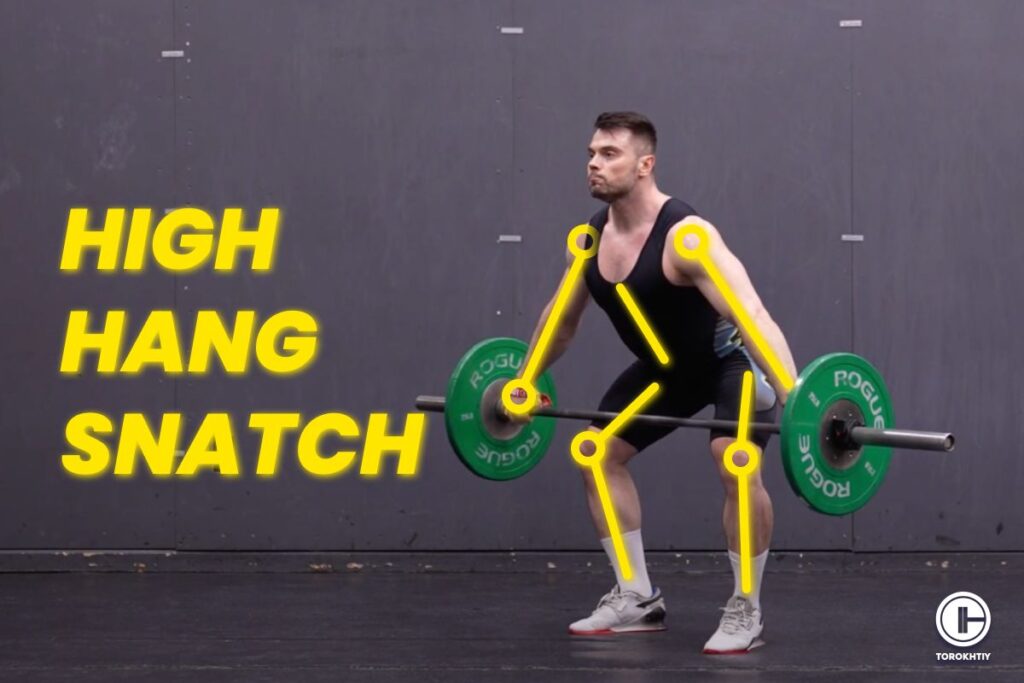
What Is the High Hang Snatch?
If this makes you think of the traditional snatch, you’re on the right track. It’s like that, but different.
You still need a lot of precision and power to do it, but unlike the snatch, the high hang snatch starts with the barbell held just above your knees. From here, you lift it explosively over your head in one fluid motion.
Its purpose is to train your body to generate maximum force quickly, which can be very useful for a lot of different sports and activities.
How to Do the High Hang Snatch?
If you’re a beginner, it would be wise to get a coach and have them help you. But whatever you decide to do, you need to know what to expect, so let’s get into how to do the hang snatch.
Save it for easy access!
Bookmark this page now to access the program and instructional videos anytime, anywhere.
Stop wasting time searching during your gym sessions.
1. Starting Position
Your feet should be shoulder-width apart and you need to grip the bar with a wide, hook grip.
Lift the bar and hold it just above your knees while your back remains straight and chest up. Your shoulders should be a little in front of the bar and your weight should be balanced midfoot. Arms are relaxed and elbows are out.
Bend your knees a bit and engage your core.
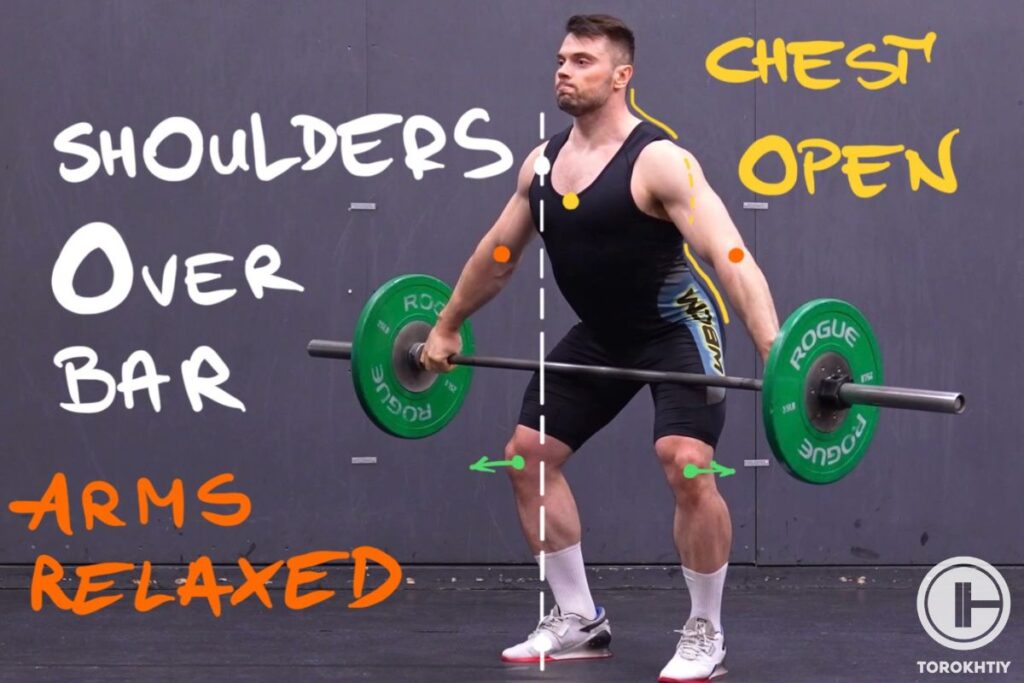
2. 2nd Pull and Power Position
With the bar in the high hang position, extend your hips, knees, and ankles and explode up.
When you reach power position (last moment when the bar is in touch with your legs) , shrug your shoulders up and back and pull the bar up with your arms with your elbows being high and pointing out.
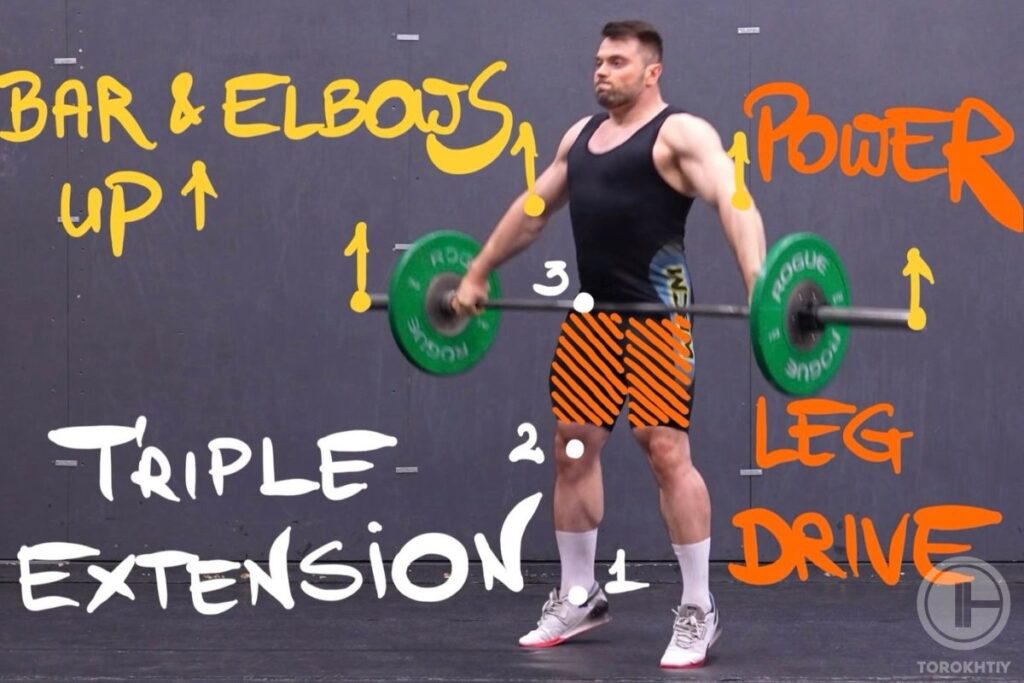
3. Turnover and Catch
When the pull is at its peak, bend your knees and hips and quickly drop under the bar. Rotate your wrists and elbows to catch it overhead with your arms totally extended.
You want to catch the bar in a deep squat with your arms being fully extended overhead. Your feet need to stay flat on the ground and your knees should be aligned with your toes.
Stay at the bottom for a second so you can stabilize the bar overhead.
It sounds like a lot of individual steps, but this should be done in a fluid motion.
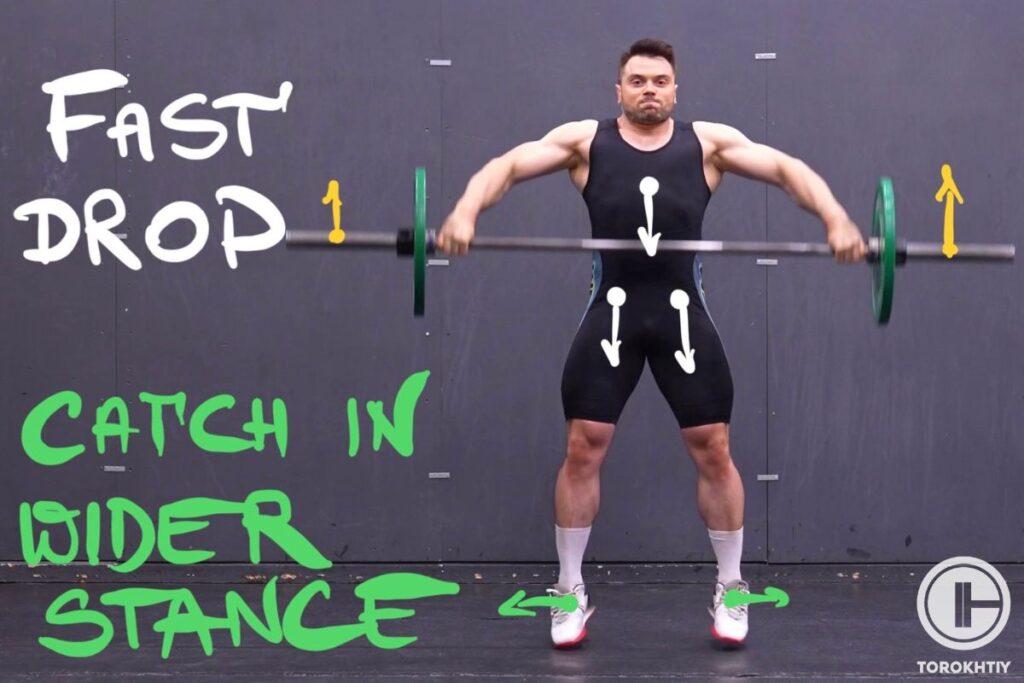
4. Recovery
Stand up from the squat and maintain control of the barbell overhead until you’re completely upright and balanced.
Lower the bar back once the lift is done and pat yourself on the back for successfully completing it!
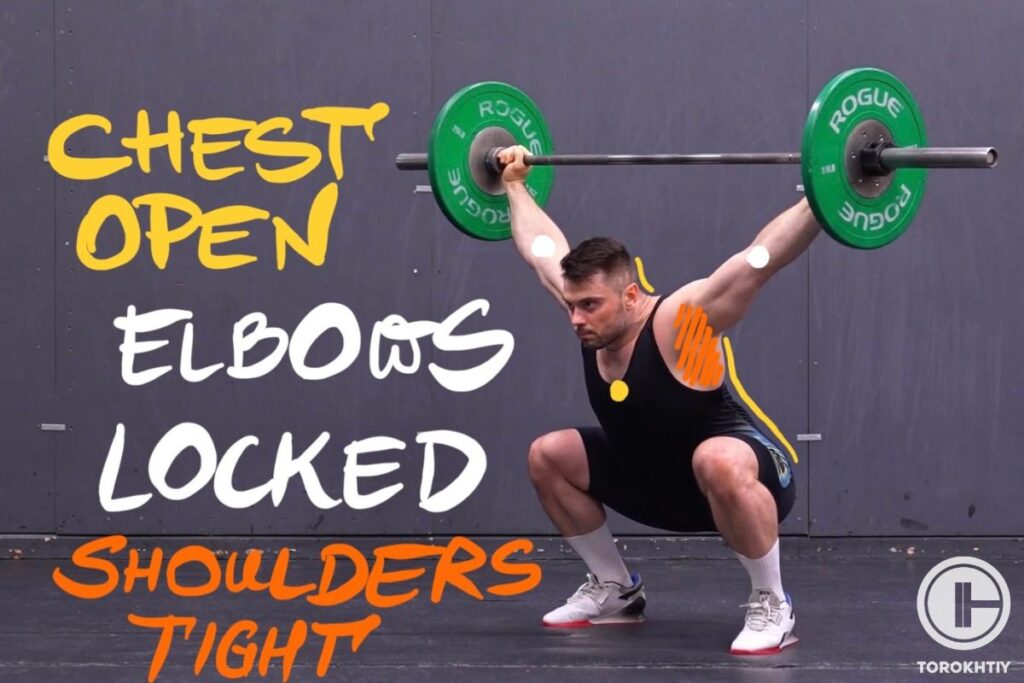
A Simple High Hang Snatch Program
| Level | Reps | Sets | Frequency |
|---|---|---|---|
| Beginner | 3-5 | 3 | 2 times per week |
| Intermediate | 2-5 | 4 | 2-3 times per week |
| Advanced | 1-3 | 5 | As much as needed |
Beginner
- Reps: 3-5
- Sets: 3
- Frequency: 2 times per week
- Progression: You’ll use super light weights or, better yet, just an empty bar. Your focus isn’t lifting heavy but mastering the form. Once that’s done, you can start increasing the weight in 5-10 lbs increments.
Intermediate
- Reps: 2-5
- Sets: 4
- Frequency: 2-3 times per week
- Progression: add exercises like the power snatch and snatch balance to develop different aspects of the lift. Start to add more weight and concentrate on speed and technique. Experiment with adding high hang snatch as a part of the olympic weightlifting complexes like: High Hang Snatch + Snatch + Overhead Squat
Advanced
- Reps: 1-3
- Sets: 5
- Frequency: as much as needed
- Progression: You want to use heavy enough loads while maintaining perfect form and explosive speed. Do complex routines that have different snatch variations in one session. Use periodization to plan your training cycles, including phases of building strength, refining technique, and peaking.
Follow us!

Free!
Get a 2-week Weightlifting Program as a bonus for the subscription to kickstart your training plan!

Free!
3 Common High Hang Snatch Mistakes
Even those super experienced make mistakes! Here are some common ones and ways to fix them:
❌ Using the Arms Too Much
A lot of people rely on their arms too much to lift the bar when they should actually use the explosive power of their hips and legs. If you use your arms in this way, the lift won’t be as effective and you can even end up injured.
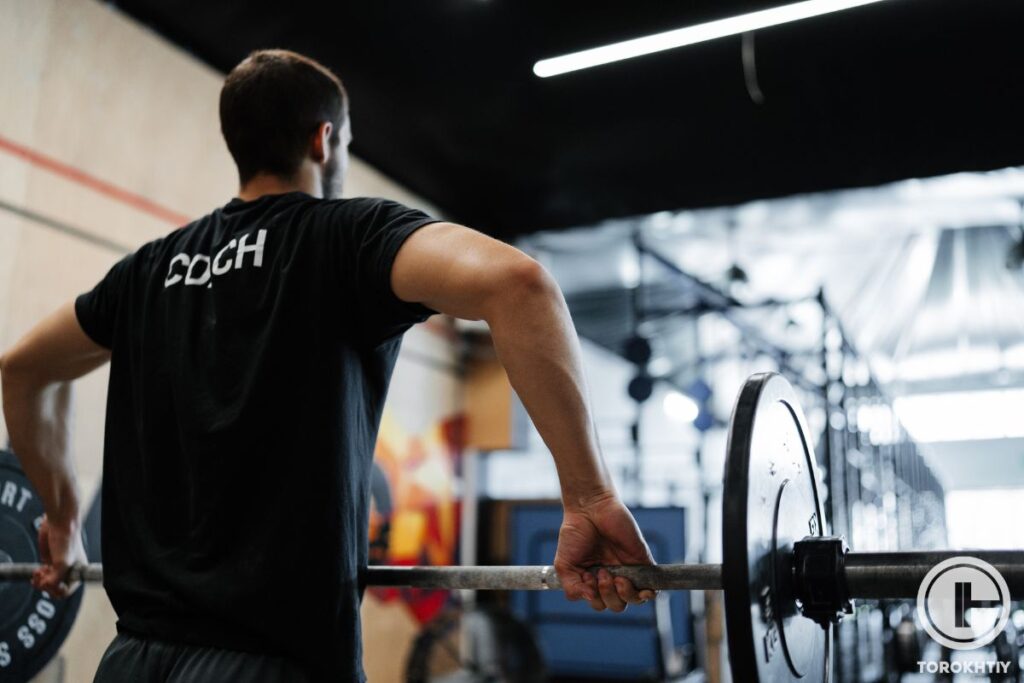
❌ Poor Catch Position
You always need to catch the bar with locked arms and a stable overhead position, otherwise you might drop the bar. Practice some snatch balances to improve stability and confidence.
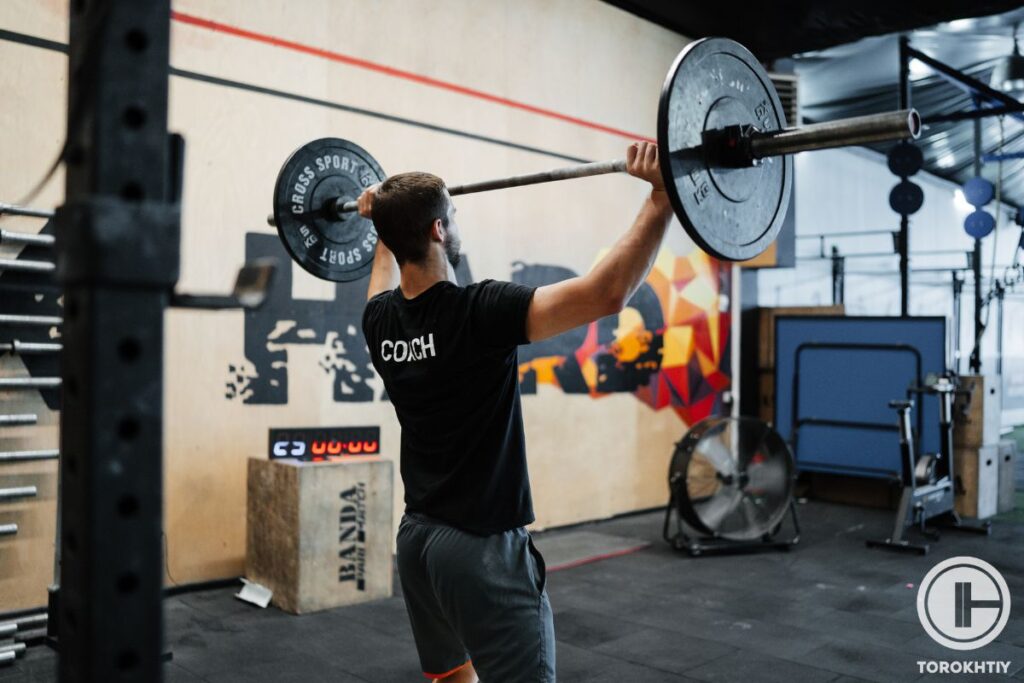
❌ Rushing the Lift
If you move too quickly through the lift, you’ll lose control, not to mention how you’ll mess your form up, which can cause injuries.
Slow down, break the lift into segments during practice and make sure your form is okay before speeding up.
🔻5-week Snatch Training Program!
Develop your snatch with the Snatch Training Program!💪
🏋️♂️Achieve:
- 🔹Achieve new Snatch Records.
- 🔹Master Snatch variations.
- 🔹Enhance technique and strength.
- 🔹Targeted drills for Snatch perfection.
⚡Highlights:
- 🔹5 Days / Week
- 🔹Varied Snatch Lifts
- 🔹Focus on Strength & Technique
- 🔹Smart Warm-Ups.
Dominate your Snatch game NOW! 💥
3 Benefits of High Hang Snatch
✅ More Power and Explosiveness
If you want to properly execute the high hang snatch, you’ll need to quickly and forcefully extend your knees, hips, and ankles, which will do wonders for your ability to quickly generate power.
✅ Better Coordination & Balance
This is a complex lift that needs precise coordination between different muscle groups. If you keep at it, you can expect better neuromuscular control and balance.
✅ Increased Bone Density
Weight-bearing exercises like the high hang snatch help stimulate bone tissue growth and increase bone density. This is important for preventing osteoporosis and keeping your bones strong and healthy as you age.
Tips From the Champ
When I’m focusing on refining the second pull, the high hang snatch is my best choice. Starting from this position forces you to generate maximum power in a short range, which in my experience, really hones your explosive strength and bar path efficiency.
Olympic Weightlifting Champion
4 High Hang Snatch Alternatives
1. Dumbbell/ Kettlebell Snatch
You’ll use dumbbells or kettlebells instead of the barbell and you’ll do the snatch but with each arm independently. It will improve unilateral strength and address muscle imbalances that can cause injuries.
2. Snatch Balance
You’ll start with the bar on your shoulders in a back squat position and then quickly dip and drive to push the bar overhead while dropping into the squat. This exercise will improve your stability and confidence in the catch position.
3. Muscle Snatch
Start with the barbell at hip level, then forcefully extend your knees, hips, and ankles to drive the bar up. Keep pulling with your arms to continue lifting and then rotate your wrists to bring the bar overhead in one motion.
Muscle snatch helps develop strength in your upper body, especially in the shoulders, traps, and triceps.
4. Power Snatch
Lift the bar off the ground with a strong pull. As it reaches its highest point, drop under it and catch it overhead with knees slightly bent. Then, stand up to complete the lift.
This alternative will help you develop explosive power, speed, and technique and it’s less demanding on the mobility of ankles, hips, and thoracic spine compared to a full snatch.
Who Should Do the High Hang Snatch?
1. Weightlifters
Well of course, right? It’s a lift, it makes sense that lifters should do it. The high hang snatch will improve their snatch technique and power output.
2. Fitness Enthusiasts
If you’re not a lister but you’re interested in functional strength and full-body conditioning, give the high hang snatch a try. You’ll get a way to challenge yourself and target multiple muscle groups at the same time.
3. Athletes
A lot of athletes will want to develop their explosive power (think sprinting, jumping, throwing, etc.) so they’ll benefit from the high hang snatch.
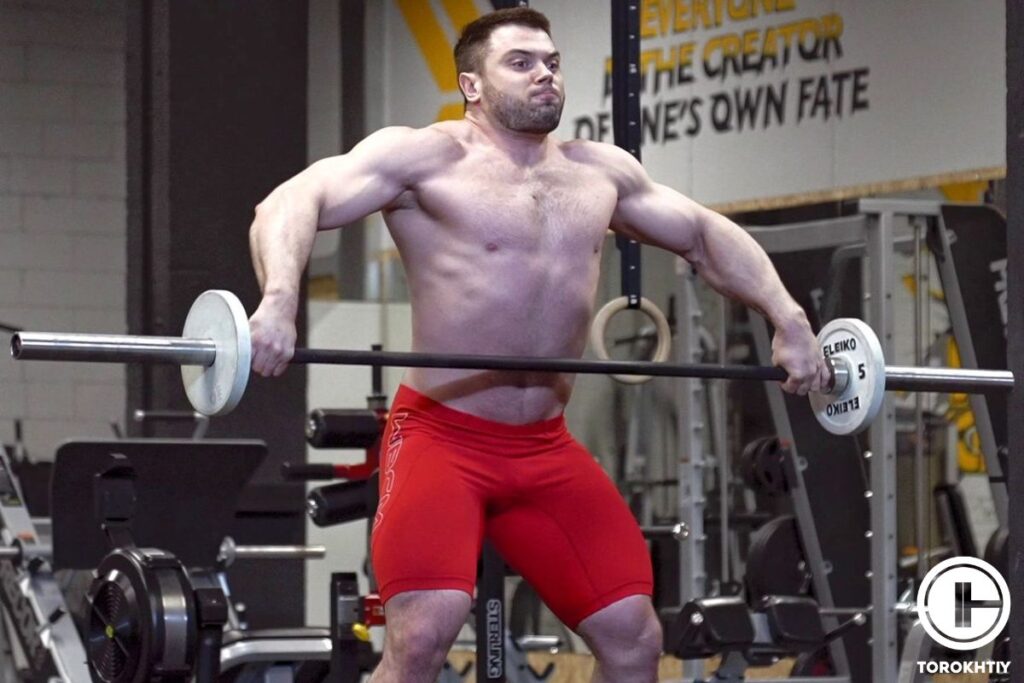
Muscles Worked by the High Hang Snatch
The high hang snatch targets mostly your lower body, but it doesn’t stop there. It also engages your posterior chain that stabilizes the spine and shoulders during the lift. Your traps, deltoids, and core get a good workout, too, because they are activated to keep you stable and balanced in the overhead phase.
Conclusion
Are you excited or scared? If you’re a beginner, there’s a chance you’re intimidated because it’s a complex exercise. But remember that you can break it down, practice individual steps, and you can’t do it overnight. It takes time and sweat, but it’s worth it.
If you’re excited to start, just make sure not to rush it, always prioritize form, and don’t forget to have fun in the process!
That’s that from us, what do you have to say to this? Have you ever even heard of the high hang snatch or is this news to you? How do you keep your fitness routine fresh and interesting? Are there any variations or alternatives to the high hang snatch you’d recommend?
Drop a comment and share your thoughts!
Stay safe and happy lifting!
References:
- Health Promotion Board (HPB) “Prevent Injuries with Proper Form During Workouts,” Singapore University Health Center, https://www.nus.edu.sg/uhc/articles/details/prevent-injuries-with-proper-form-during-workouts (accessed June 20th, 2024)
- “Prevention Osteoporosis,” National Health Service, https://www.nhs.uk/conditions/osteoporosis/prevention/ (accessed June 20th,2024)
- “Slowing bone loss with weight-bearing exercise,” Harvard Health Publishing, https://www.health.harvard.edu/staying-healthy/slowing-bone-loss-with-weight-bearing-exercise (accessed June 20th, 2024)
- Venkat S. R. “What Are Muscle Imbalances?” WebMD, https://www.webmd.com/fitness-exercise/what-are-muscle-imbalances (accessed June 20th, 2024)
- Photos by Torokhtiy Media Team.
Why Trust Us?
With over 20 years in Olympic weightlifting, strength training, nutrition coaching, and general fitness our team does its best to provide the audience with ultimate support and meet the needs and requirements of advanced athletes and professional lifters, as well as people who strive to open new opportunities and develop their physical capabilities with us.
By trusting the recommendations of our certified experts in coaching, nutrition, and sports training programming, as well as scientific consultants, and physiotherapists, we provide you with thorough, well-considered, and scientifically proven content. All the information given in the articles concerning workout programming, separate exercises, and athletic performance, in general, is based on verified data.
The product testing process is described in more detail here.
Author: Oleksiy Torokhtiy
Olympic Weightlifting Champion
Best Results: Snatch – 200 kg,
C&J – 240 kg
Oleksiy Torokhtiy is a professional athlete boasting 20 years of experience in Olympic weightlifting. With multiple European and World titles under his belt, he has showcased his prowess in two Olympic Games (Beijing 2008 and London 2012). Upon concluding his illustrious career, Oleksiy dedicated himself to coaching. By 2022, he had conducted over 200 weightlifting seminars worldwide. He is the visionary behind an international sportswear and accessories brand known for its motto, “Warm Body Cold Mind.” Additionally, he is an esteemed author and the creator of a series of training programs and eBooks.

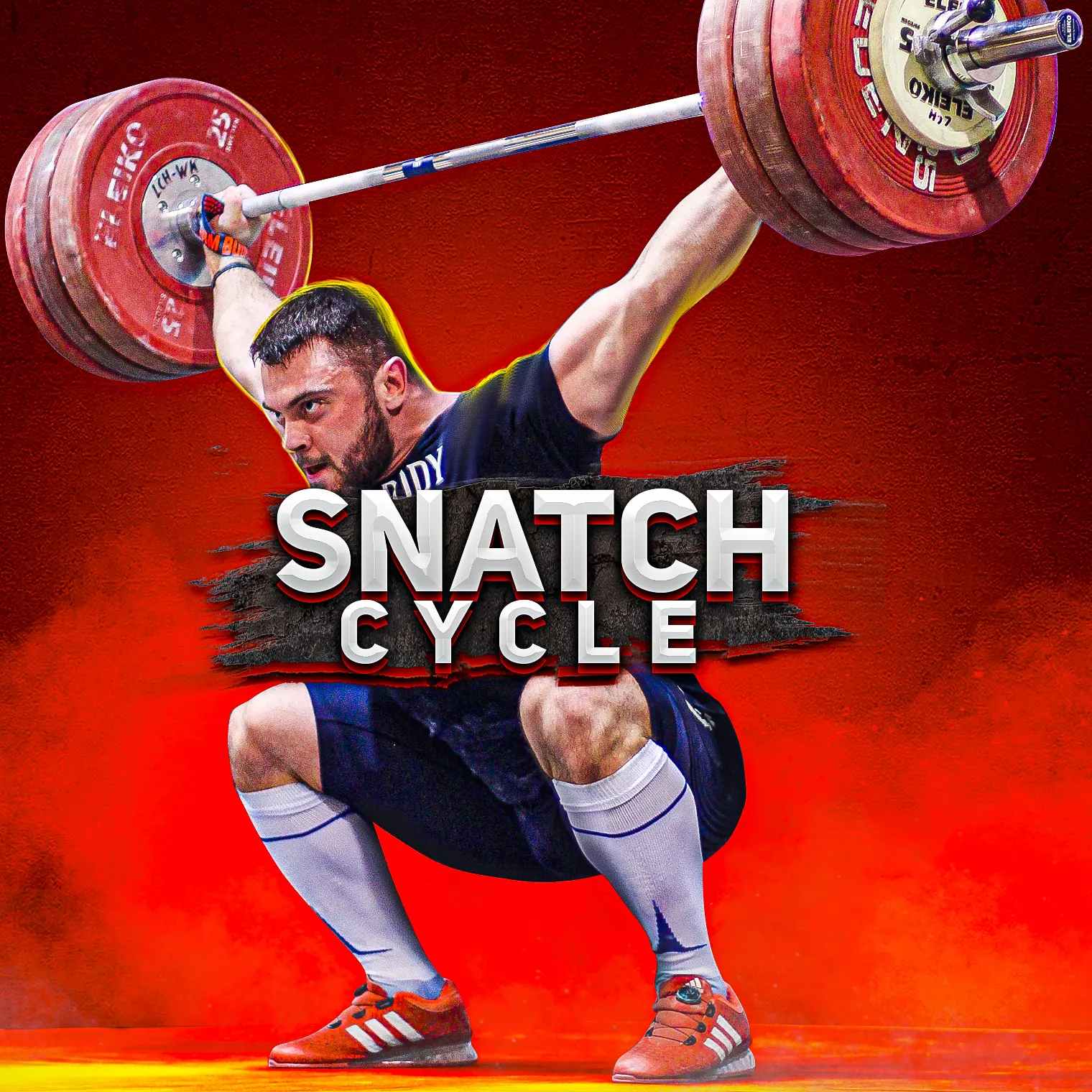


Still have questions after reading our article? Unlock your full potential by engaging with our experts and community! Don’t hesitate — leave a comment below and Oleksiy Torokhtiy will provide a personalized answer and insights to help you reach your goals.